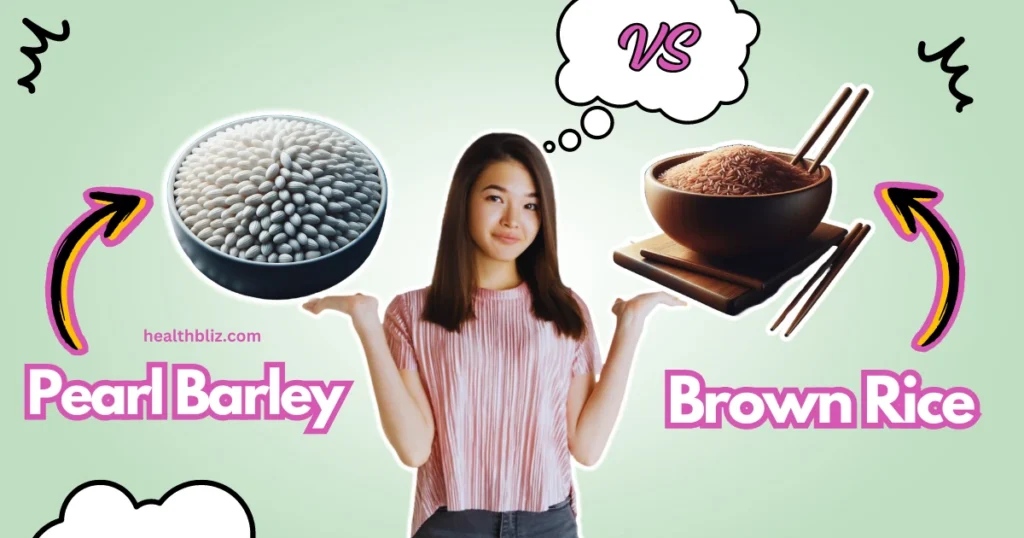
When it comes to choosing between pearl barley and brown rice, you might find yourself in a bit of a conundrum. Both grains have their own set of nutritional benefits and culinary uses, making it challenging to determine which one is truly superior. The comparison is a difficult one because both of these grains are similar in many ways. Both are high in nutritional value and provide numerous health benefits. In this article, we’ll look in depth at the differences between pearl barley and brown rice to help you make an informed decision.
Comparison Between Pearl Barley vs Brown Rice
1. Nutritional Comparison
Here’s a comparison of the nutritional profiles of pearl barley and brown rice (1, 2).
| Nutrient | Pearl Barley (Cooked, 1 cup) | Brown Rice (Cooked, 1 cup) |
|---|---|---|
| Calories | 193 | 216 |
| Protein (g) | 3.5 | 5 |
| Total Fat (g) | 0.7 | 1.8 |
| Carbohydrates (g) | 44.3 | 45.8 |
| Dietary Fiber (g) | 6 | 3.5 |
| Sugars (g) | 0.6 | 0.7 |
| Calcium (mg) | 18 | 20 |
| Iron (mg) | 1.3 | 0.8 |
| Magnesium (mg) | 44 | 83 |
| Phosphorus (mg) | 107 | 162 |
| Potassium (mg) | 54 | 84 |
| Sodium (mg) | 6 | 5 |
| Zinc (mg) | 0.9 | 1.2 |
| Vitamin B1 (mg) | 0.1 | 0.2 |
| Vitamin B3 (mg) | 2.3 | 2.6 |
| Vitamin B6 (mg) | 0.2 | 0.4 |
| Folate (mcg) | 11 | 8 |
| Selenium (mcg) | 6.5 | 19 |
Pearl barley is a refined variation of barley that undergoes a process where its outer husk and bran layers are removed. Despite this refinement, pearl barley retains its nutritional value, containing important nutrients such as fiber, vitamins, and minerals like manganese, selenium, and phosphorus. A standout component of pearl barley is its high content of beta-glucan, a soluble fiber known for its ability to lower cholesterol levels. Additionally, pearl barley offers a moderate amount of protein, making it a fulfilling option for individuals who adhere to a vegetarian or vegan diet.
Brown rice is a type of whole grain that maintains its husk and germ layers, resulting in a higher nutritional value compared to white rice, which is refined. It is packed with fiber, antioxidants, and vital nutrients like magnesium and selenium. Moreover, brown rice contains phytochemicals such as lignans and phenolic compounds, which have been associated with numerous health advantages, including a reduced risk of heart disease and enhanced digestion. Furthermore, brown rice serves as an excellent source of complex carbohydrates, offering sustained energy levels and a sense of fullness.
2. Glycemic Index
Pearl barley has a low glycemic index (GI), indicating that it causes a gradual and steady increase in blood sugar levels after consumption. This makes it an excellent choice for people who have diabetes or want to manage their blood sugar levels effectively. The soluble fiber in pearl barley slows the absorption of glucose in the bloodstream, preventing rapid spikes and drops in blood sugar levels.
Brown rice has a moderate glycemic index, but slightly higher than pearl barley. However, brown rice has a significantly lower GI than white rice due to its higher fiber content and slower digestion rate. Brown rice can help stabilize blood sugar levels and lower the risk of insulin resistance, making it a good option for diabetics or those concerned about their metabolic health.
3. Selenium
The presence of selenium is known to decrease the risk of colon cancer. Selenium’s dietary fiber content enhances the level of protection against this disease.
Brown rice is particularly abundant in selenium. Therefore, including brown rice and other selenium-rich foods in your diet can play a crucial role in preventing the onset of colon cancer.
4. LDL cholesterol
Pearl barley contains beta-glucan, a soluble fiber that can help lower LDL cholesterol levels in the blood. Consuming pearl barley as part of a well-balanced diet may help to lower LDL cholesterol and reduce the risk of heart disease.
Brown rice is also good for lowering LDL cholesterol because of its high fiber content and complex carbohydrates. Brown rice contains fiber, which helps remove cholesterol from the body, resulting in lower LDL cholesterol levels and better heart health.
5. Blood pressure
Pearl barley reduces cholesterol levels and improves cardiovascular health in general. It also helps to regulate blood pressure and lowers the risk of heart disease and stroke. Aside from these, brown rice contains over five times more folate and vitamin E than organic pearl barley.
Pearl barley also contains twice as much calcium and fiber as rice and has about 30% fewer calories. Barley has less sodium than rice, but the two are nearly equal in protein and fat content.
Barley is a seed that is often overlooked and replaced with something more familiar, such as rice or oats. However, the benefits of pearl barley should not be overlooked because it is extremely nutritious and improves overall health. To summarize, pearl barley has a high nutritional value, but the same can be said for brown rice. So, there are other factors to consider when deciding which food is healthier. Brown rice is the clear winner for a gluten-free diet, as barley contains gluten. However, in terms of nutritional value, both grains are healthy options that can be added to a variety of meals.
Uses of Barley vs. Brown Rice
Uses of Barley
Barley is a highly nutritious grain that is not only affordable but also easy to cook. Its chewy texture and nutty flavor make it a versatile ingredient that can be incorporated into a wide range of dishes, including porridge, salads, and stuffings. Additionally, barley can add a unique texture to soups and stews, and it can even be used to make a nourishing tea.
Start with this simple lemon barley water:
- Boil barley with lemon zest, then strain the liquid.
- Combine it with fresh lemon juice and honey.
- Enjoy it hot or chill it in the refrigerator for a refreshing sweet and tart beverage.
- Add freshly grated ginger to the boiling water for a spicy kick.
Uses of brown rice
Brown rice is an excellent substitute for white rice in any rice-based dish. So use it in biryani, pilaf, or simply bisibele bhaat to enjoy its delectable flavor. Brown rice is occasionally soaked and germinated to increase its nutritional density. It works well in a pudding, a quick stir fry, and even a risotto, but barley wins out in this one simply because of its texture. Brown rice, however, may be a better choice for a Mexican rice bowl with avocados and salad.
Pearl barley is quicker and easier to cook than brown rice, but the grainier texture of brown rice may be preferable for biryanis and pilaf.
Frequently Asked Questions
Q1: Is pearl barley healthier than rice?
A1: Both pearl barley and rice offer unique nutritional benefits, so neither is definitively healthier than the other. It ultimately depends on individual dietary preferences and nutritional needs.
Q2: Is brown rice gluten-free?
A2: Yes, brown rice is naturally gluten-free, making it suitable for individuals with gluten sensitivities or celiac disease.
Q3: Can I soak barley or brown rice before cooking?
A3: Yes, soaking barley or brown rice before cooking can help reduce cooking time and improve digestibility. Soaking grains overnight in water can soften them, making them easier to cook and digest.
Q4: Is brown rice better than white rice?
A4: Brown rice is considered healthier than white rice because it retains its bran and germ layers, which contain valuable nutrients like fiber, vitamins, and minerals. White rice, on the other hand, is processed and stripped of these nutritious layers, resulting in a less nutritious product.
The bottom line
Both pearl barley and brown rice offer valuable nutritional benefits and can be used in a variety of culinary dishes. Pearl barley is particularly notable for its high fiber content and unique beta-glucan properties, which can help lower LDL cholesterol levels and improve heart health. On the other hand, brown rice provides essential nutrients like selenium and antioxidants that support overall well-being. When deciding between these grains, it is important to consider individual dietary preferences, health goals, and culinary preferences. By incorporating both pearl barley and brown rice into a balanced diet, individuals can enjoy a diverse range of nutrients and flavors, thereby enhancing the overall nutritional value of their meals.


